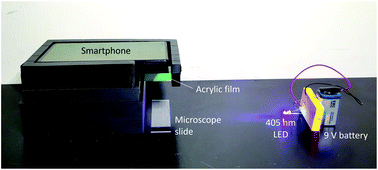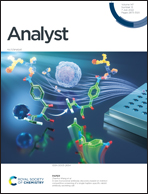Smartphone-based autofluorescence imaging to detect bacterial species on laboratory surfaces†
Abstract
The potential of bacterial contamination is commonly seen in biological and clinical laboratory surfaces, creating a need to detect the presence of bacteria on a surface. Various bacterial species have been found to naturally exist on surfaces, including Escherichia coli, Salmonella Typhimurium, and Staphylococcus aureus that were investigated in this study. Bacterial presence was identified from laboratory surfaces using a smartphone and low-cost components without culturing or staining. Autofluorescence from bacteria was quantified using a 405 nm LED as an excitation light source. A low-cost acrylic film could isolate the autofluorescence emission. ImageJ was used to process and analyze the images and quantify the emitted autofluorescence signal. This imaging platform successfully detected the presence of all three bacterial species from the heavily used laboratory surfaces. A trend of decreasing fluorescence signal was observed with decreasing bacterial concentration, and the limit of detection was 104 CFU cm−2. It could also distinguish from tap water, protein (bovine serum albumin), and NaCl solutions. This preliminary work emphasizes the ability to detect autofluorescence signals of bacteria and non-microbial surface contaminants using a cost-effective and straightforward imaging platform.

- This article is part of the themed collection: Analyst HOT Articles 2022


 Please wait while we load your content...
Please wait while we load your content...